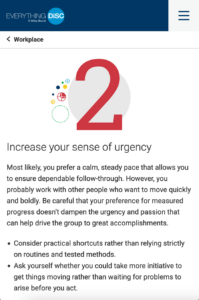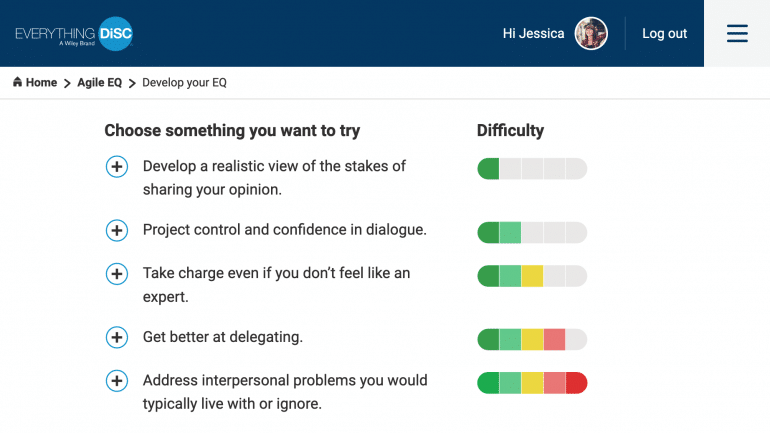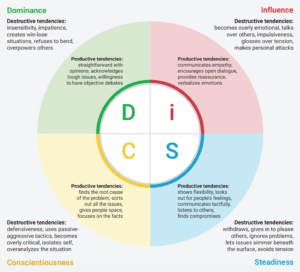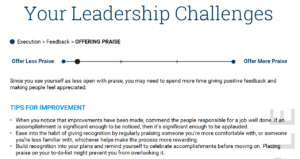Some people delight in making New Year’s resolutions; some people scorn them. Since an estimated eight percent of resolution-makers achieve their goals, it can be easy to get discouraged before you start. But people who make resolutions on New Year’s, when compared with people who intend to make a change later, are more than ten times more likely to be experiencing success in their goal six months into the year.
Of course, just making the resolution isn’t enough. There are steps you can take to help your resolution stick, such as breaking big goals into smaller pieces, telling others about your goal, and tracking your progress. Research shows that “approach goals” (what you want to move toward) yield better results than “avoidance goals” (what you want to move away from). And as you’re clarifying the what and how of your goals, don’t forget about the why.
DiSC® assessments are a useful, personalized source of ideas for creating and following through on New Year’s resolutions. Each Everything DiSC® profile includes action steps you can take to improve in areas such as emotional intelligence, communication, leadership, and dealing with conflict. If you’ve taken an Everything DiSC assessment in the past, revisit it as you prepare for the New Year. If you haven’t taken one, we recommend you start with Everything DiSC Workplace®.
DiSC trainers: Use the suggestions below as an activity during an end-of-year or start-of-year meeting, or any other time you want your learners to engage in goal setting.
Everything DiSC Workplace®
Traditional Workplace profile: page 16, “Taking Action”
Catalyst platform: Workplace > What drives you > Strategies
Action Plan worksheet (PDF)
The “Taking Action” (traditional Workplace profile) or “Strategies” (Catalyst) section gives you three key strategies to work better with people of all styles. Choose one and review the bullet points below it. Craft this into a resolution with measurable outcomes.
Workplace resolution example
An SC-style individual may review their profile and decide to work on bringing more urgency to their work. Here’s how they could make that goal more concrete:
New Year’s resolution: I resolve to bring more of a sense of urgency to my work this year.
Why: My preference for a calm routine can dampen the passion of others on my team and make me miss opportunities. Bringing urgency to my work will benefit my team and bring me excitement.
How: Find four times this year when I can take initiative by proposing a new idea or addressing a problem.
- Set a monthly calendar reminder to make sure I don’t forget about this resolution.
- Keep a document or journal where I record the four instances—what I did, how it felt, and what the results were.
- Share this resolution with my peers and my mentor.
Everything DiSC® Agile EQ™
Traditional Agile EQ profile: pages 15-25, “Becoming Agile”
Catalyst platform: Agile EQ > Develop your EQ
Action Planning worksheet (PDF)
Choose a mindset outside your comfort zone. Review “Getting into the mindset” and “Where should you start?” to identify a goal you’d like to work on. Complete the “Action Planning” worksheet on page 26. (Download extra planning worksheets here [PDF].)
Agile EQ resolution example
Someone with an iS style may look through their Agile EQ profile, fill out the Action Plan worksheet something like this (PDF), and resolve to be better at delegating:
New Year’s resolution: I resolve to get better at delegating.
Why: I want to be more of a leader at work, and I can’t do that if I’m afraid to speak my mind, stand up for myself, or displease someone.
How:
- Write “Everyone benefits when I delegate” on a sticky note where I’ll see it every day.
- Audit my tasks and determine which fall outside the scope of my job responsibilities.
- Choose one each month to address until the list is complete.
- Make a plan to hand it off, consulting with my manager and team as needed.
- Keep a journal about how I approached each task hand-off and how it made me feel before and after. Does everyone hate me now as I secretly feared, or is the reality a bit less dramatic?
For tips on stretching into each of the eight Agile EQ mindsets, see our article series on how to be more receptive, composed, objective, resolute, self-assured, dynamic, outgoing, or empathetic.
Everything DiSC® Productive Conflict
Pages 20-23, “Changing Your Response” and “Choosing Productive Responses”
Productive Conflict Log (PDF)
First, look at the overview of DiSC styles in conflict on page 5. Review your productive and destructive tendencies and think about what you’d like to work on. A C-style person may want to be less passive-aggressive. An i-style individual might want to talk over others less.
Learn about your chosen destructive response in the “Why do I do this?” section, pages 12-18, and identify the automatic thoughts that most often drive this behavior for you.
Commit to using the Productive Conflict Log (PDF) after each conflict you encounter during the year (also on page 23 of the profile). Each time you do, you’ll get better at identifying and reframing the thoughts driving the conflict behavior you’d like to change.
Productive Conflict resolution example
A C-style person’s New Year’s resolution may look something like this:
New Year’s resolution: I will be more direct and assertive in conflict situations. (This uses approach-oriented language, rather than the avoidance-oriented “I resolve to be less passive-aggressive.”)
Why: When I am passive-aggressive, I never feel good about it after the conflict, and it doesn’t help my team achieve our goals.
How: I will work to identify the automatic thoughts driving my behavior, and use the conflict log to reflect on my thoughts and choices after each conflict. I will also share my resolution with my peers so they can help support me.
Everything DiSC® Management
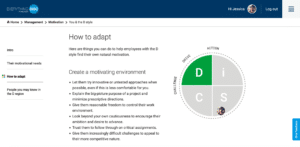 Click for larger image.
Click for larger image.If your New Year’s resolution is to be a better manager, look to Everything DiSC Management®.
Of course, “be a better manager” is too general of a goal to make for a successful resolution. Instead, get more specific about the changes you’d like to make:
- “I resolve to make myself more available for my employees.”
- “I resolve to delegate with more clarity and details.”
- “I resolve to offer positive feedback more often.”
Review the section of the profile that relates to your resolution (delegating, talent development, etc.). For example, someone focusing on motivation would review:
- On Catalyst, the Management > Motivation > Adapt to others section
- In the traditional Management profile, pages 13-16, “Motivating the DiSC styles”
Management resolution example
Here’s how a manager could work throughout the year on personalizing their motivation strategies for each of their employees.
New Year’s resolution: I resolve to create a more motivating environment for my employees.
Why: My team shows signs of the wear and tear of the past two years. Many of my employees seem checked out, and I’m worried about them leaving the company. With so much stress outside of work, I want to do what I can to make work an engaging and fulfilling space for my team.
How:
- Remember that each employee has different motivational needs. Review my Management profile to learn what motivates and demotivates each DiSC style and think about how this applies to each member of my team.
- Write down two concrete actions I can take for each employee to make them feel more motivated at work. For example, can I find more collaborative opportunities for Donna (i style)? Some healthy competition for Sally (D style)?
- Meet with each employee to discuss motivation. Hear what they find motivating and demotivating (which may depart from their style). Share my ideas with them and ask for theirs. Make a plan together.
- Create a quarterly calendar alert to assess how my motivation goal is going.
- Share my resolution with the other managers, and encourage them to create similar action plans so we can support each other throughout the year.
Everything DiSC Work of Leaders®
Pages 21-23, Your Leadership Challenges
Most of us would like to strengthen our leadership skills. But what exactly does that mean? Work of Leaders reveals a simple, actionable path to make you a more effective leader, no matter your DiSC style.
Review the final pages of the Work of Leaders profile and select a leadership challenge you’d like to work on in the new year. Review the tips for improvement, then fill out the questions at the bottom of the page. This will help you think through the benefits for you and your team as well as your specific action steps.
Work of Leaders resolution example
Someone with a D-style personality may craft a New Year’s resolution using Work of Leaders in this way:
New Year’s resolution: I resolve to offer more praise to the people in my company.
Why: If I offer positive reinforcement when people are doing good work, they will likely be more motivated and engaged.
How: By placing praise on my to-do list:
- Offer a positive comment on the work of each person who reports to me at least once a week. Check it off a list until it becomes habit.
- In my project planning documents, add a task after the completion of each phase. The task: thank the team and applaud specific contributions.
- I don’t see a lot of the day-to-day work that keeps the company running. So, I should remember that if an improvement is significant enough for me to notice, it is significant enough for me to commend.
Everything DiSC® Sales
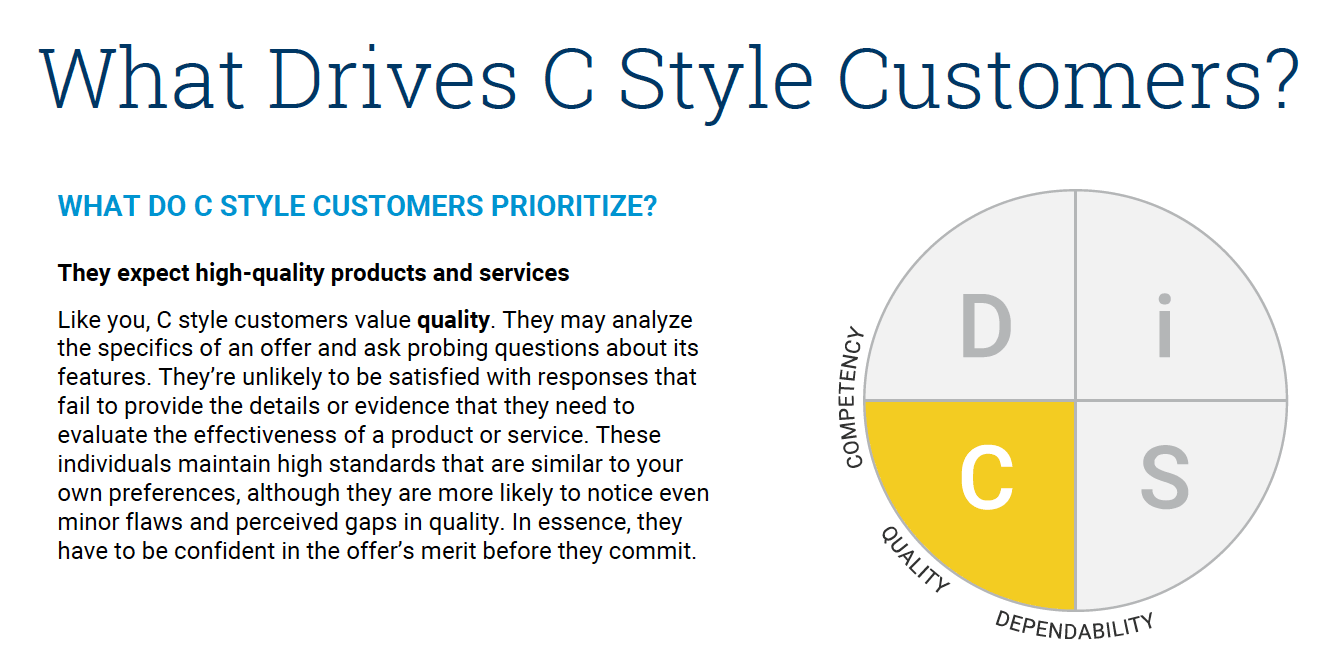
Excerpt from Everything DiSC® Sales profile.
Page 7, “Your Sales Challenges”
Page 23, Action Planning Worksheet
Review page 7, “Your Sales Challenges,” to identify a challenge you’d like to work on in the new year. For example, an S-style person who finds sincerity easier than results may focus on the challenge “I may give people so much space that they fail to commit.” Or a CD-style person who tends to prioritize competency over relationships may want to address “I sometimes neglect to empathize with customers.”
Another option for your New Year’s resolution is to embrace the larger goal of Everything DiSC Sales: to better connect with customers of all styles. Here’s how an i-style salesperson may do that:
Sales resolution example
New Year’s resolution: I resolve to be more intentional about building relationships with customers whose personalities differ from my own.
Why: I love finding common ground with all different types of people. Learning about the priorities of my customers and how they may differ from mine will make our interactions more enjoyable for both of us, and help boost my sales numbers.
How:
- Consider style before each customer contact: Before meeting with or emailing any customer, use the people-reading exercise on page 17 to estimate the customer’s DiSC style. Review the priorities of that style.
- Special focus on C style: As someone with an i style, I find connecting with C-style customers to be a particular challenge. Go through my usual talking points one by one and evaluate how well-received they might be by someone with a C style. Ask a few of my C-style friends or colleagues if I can practice pitching to them. Receive their feedback with gratitude, remembering that they may be more direct with feedback than I tend to be.
- Make it a social event: Find a couple of Resolution Buddies from the sales team to join me in this resolution. We can meet up once a month (I’ll bring the cookies!) to talk about our progress and how we can support each other.
Sticking to your New Year’s resolutions
Remember, for more successful New Year’s resolutions:
- Choose approach goals over avoidance goals.
- Think about the why, in addition to the what and how.
- Break the resolution into smaller action steps.
- Develop a plan for tracking your progress.
- Tell other people about your resolution.


